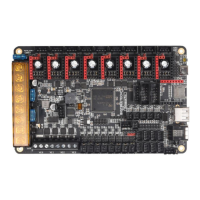17. Provides two stepper outputs, connected in parallel, to the Z driver allowing for a
parallel, dual Z axis drive.
18. Supports firmware update via DFU mode. This is where the firmware is sent to the
board directly from the PC and does not require a bootloader however this method is
not recommended for novice users as discussed later in this document.
19. Includes an onboard, 32K EEPROM (AT24C32).
20. Provides an RGB LED interface.
21. Provides a WiFi interface for ESP8266 based modules.
22. Provides a built-in PT100/1000 interface using an integrated MAX31865 amplifier.
The interface supports 2/3/4 wire connections.
23. Thermistor input protection. This allows you to short a thermistor input directly to a
voltage source (not that this makes it a good habit to pick up) up to Vin without
causing damage to the motherboard.
24. Supports BL Touch and various other ABL sensors.
25. Provides a dedicated “PROBE” port for bed probes. This port is internally protected
via an optocoupler which means that you don’t need to use a BAT85 diode.
Additionaly, the octopus-pro includes a pull up resistor on the probe port which can
be selected or deactivated using a jumper. This allows it to work with both NPN and
PNP type probes.
26. Supports CAN BUS using a 6P6C RJ11 interface, which offers the board the ability
to interface with future expansion modules.
27. Supports StallGuard for sensorless homing with TMC drivers
28. Provides an SPI expansion port which can connect the SPI-based expansion
modules.
29. Supports the shutdown after printing function.

